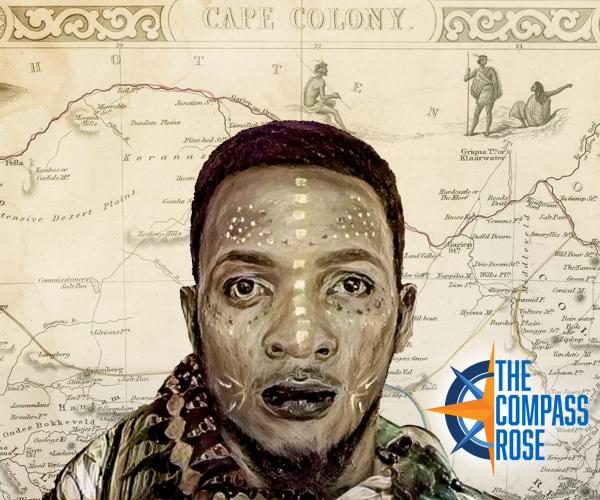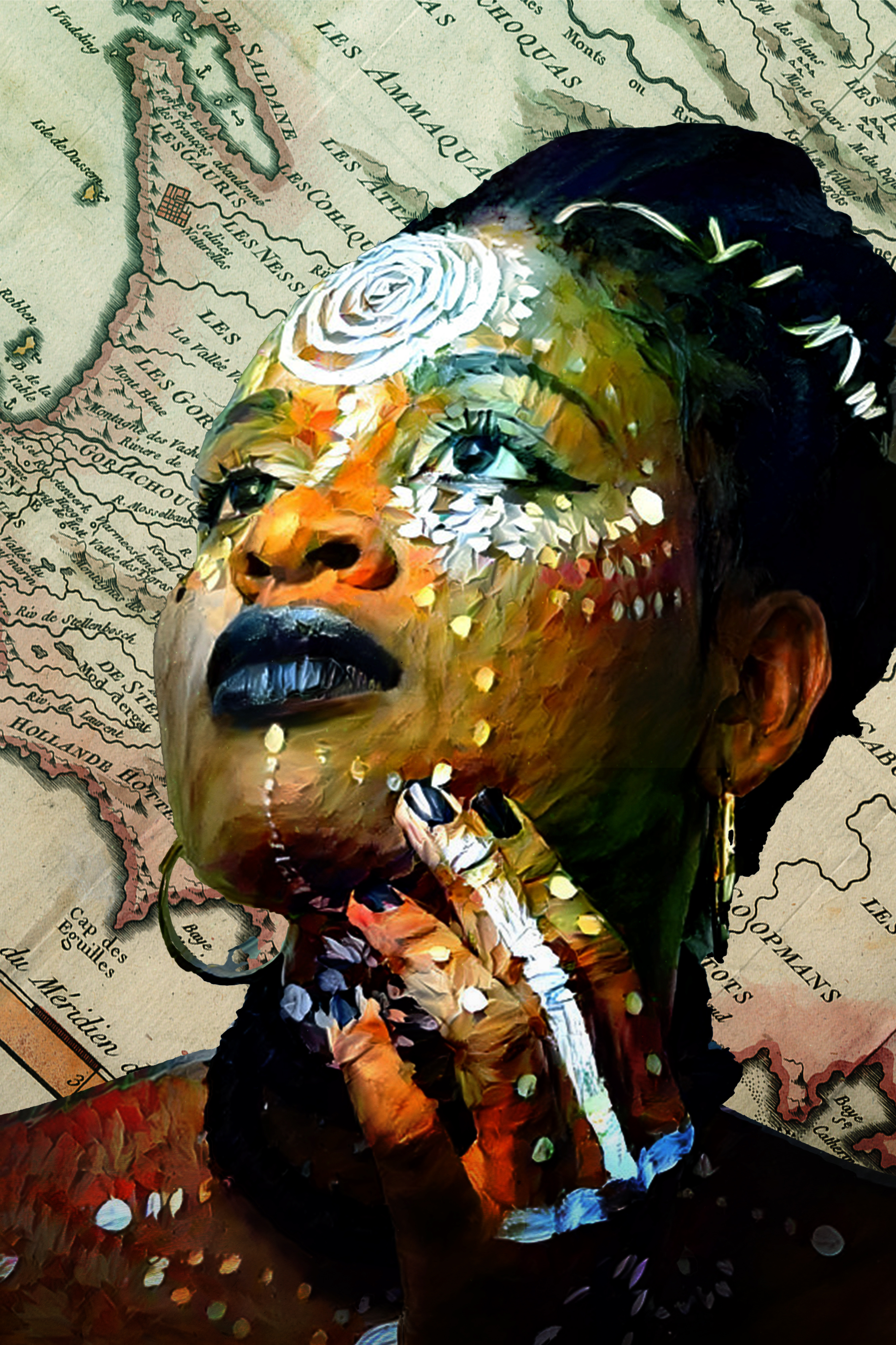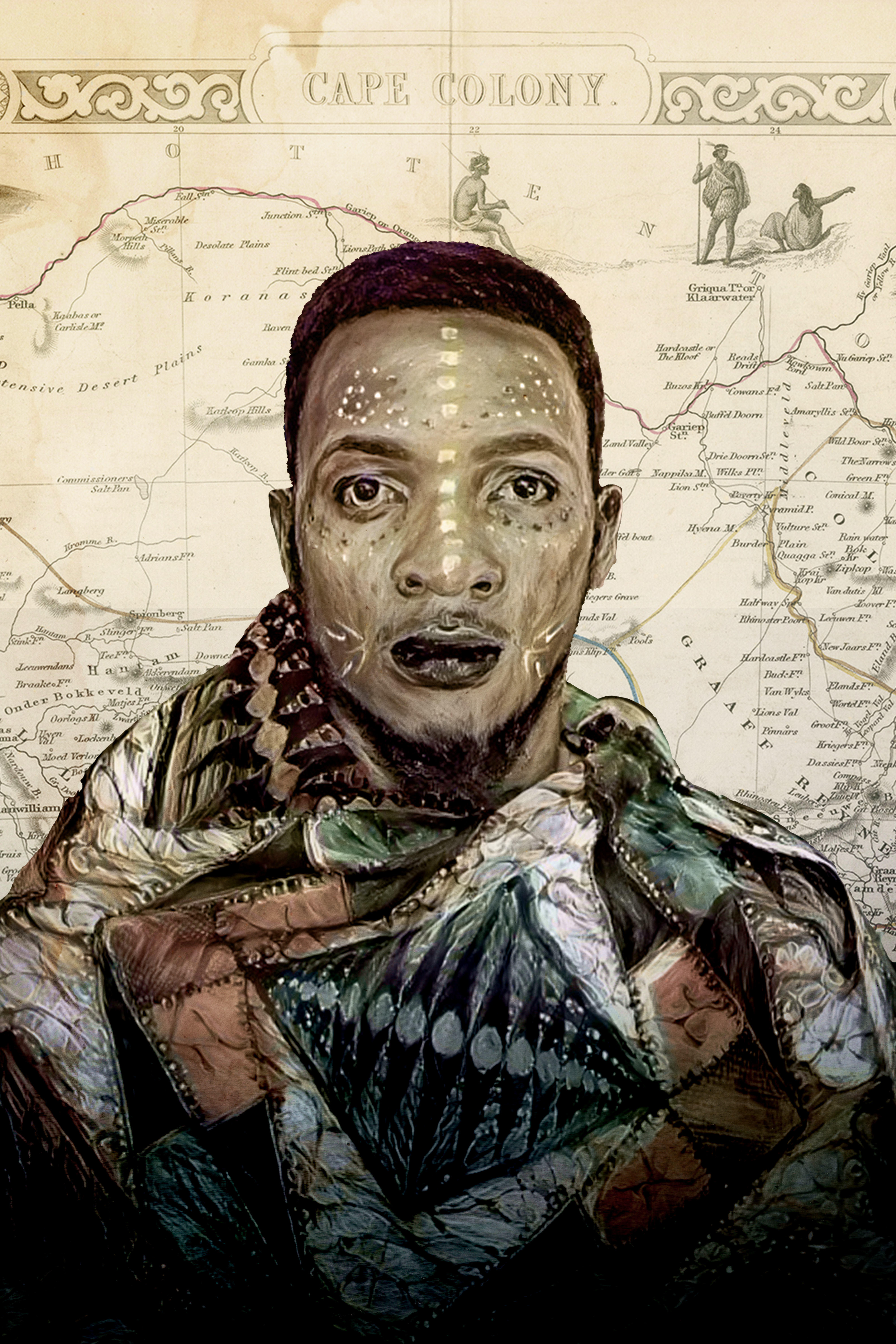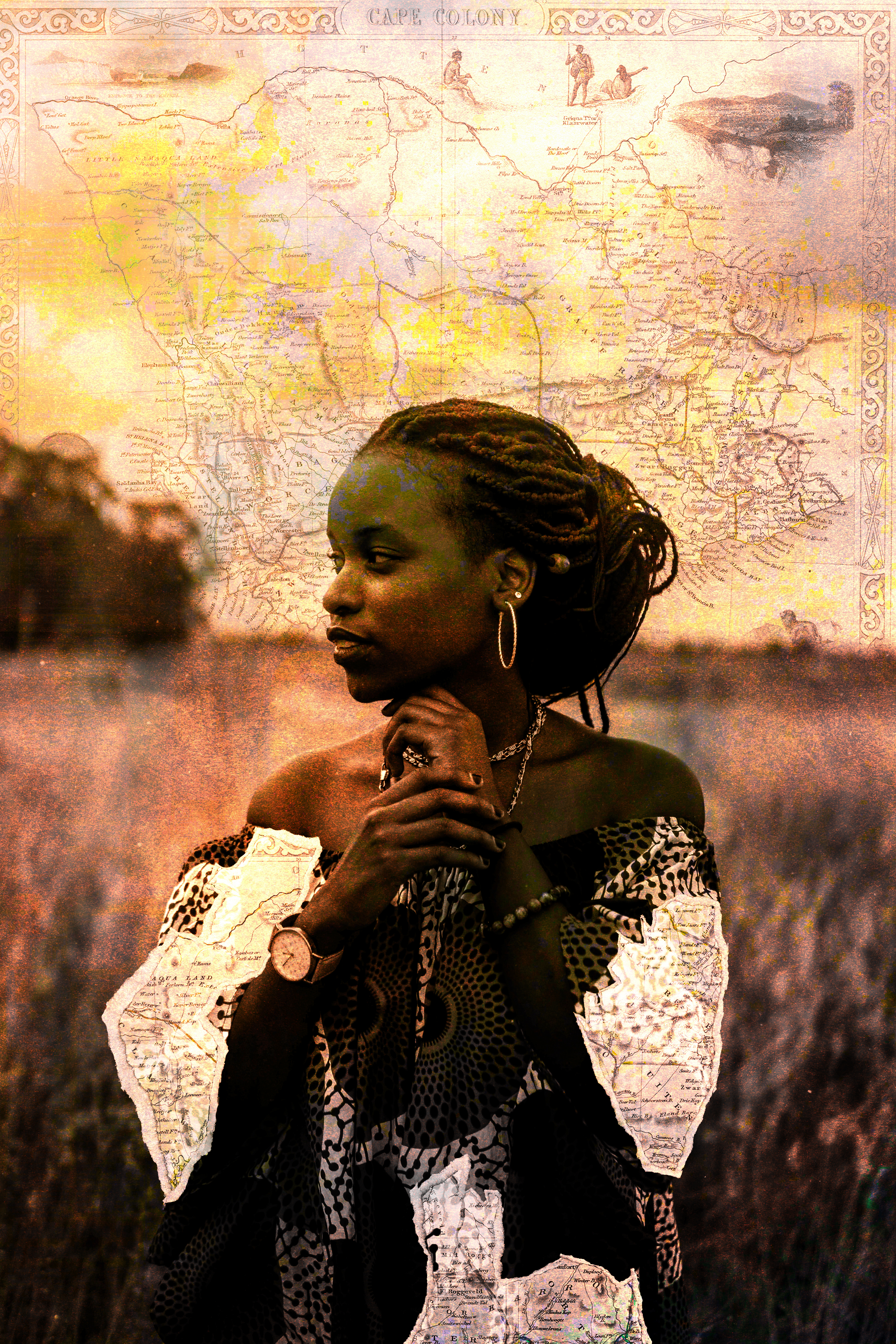
by Evan Spencer


by Evan Spencer
The purpose of The Compass Rose is to raise awareness of Special Collections’ resources and to foster the use of these resources. The blog series also reports significant new programs, initiatives, and acquisitions of Special Collections
Today, Special Collections presents a special guest post from Art undergraduate student Jeremiah Alcorn and his professor Dr. Leah McCurdy. Jeremiah presents a series of designs he produced, and Dr. McCurdy contextualizes his work with respect to the class and African history. They developed this post as part of the Art of Sub-Saharan Africa class explorations of the Searching for Africa exhibition in Special Collections during the fall 2021 semester. View blog posts from Dr. McCurdy’s students, Deb Vickery, Rebeca Compean-Serrano, and Ashlei Jones.

Jeremiah Alcorn
Several students in my Art of Sub-Saharan Africa course published written expressions of their response to viewing the Searching for Africa exhibition in December. They’ve shared diverse perspectives about the meaning that historic archives like the Map Collection of Dr. Jack Franke can have in our lives today. To mark the closing of the exhibition in early January, we offer a final post demonstrating a distinct kind of response.
Art history courses often host many studio arts and graphic design students who do not necessarily find writing a comfortable or preferable form of expression. Instead, many of my students seek to express their understanding of art history through visual means. One such student this semester is Jeremiah Alcorn, who is seeking his degree through our Visual Communication Design program. Looking Up (Figure 1), Looking Out (Figure 2), and Looking Forward (Figure 3) are a series of digital works Jeremiah produced to bring a contemporary and humanizing perspective to historic maps of South Africa featured in the Searching for Africa exhibition. Jeremiah was drawn to the history of South Africa because of how much it resonates with the history of the United States with which he is more familiar.
As his professor, I see all the hallmarks of our class discussions and visits to Special Collections embedded in this series. These hallmarks may not be clear or meaningful to the readers of this blog without context. To celebrate Jeremiah’s work, I share three primary observations I draw from these images that I hope will inspire readers to explore Special Collections resources (those on exhibit and stored away) and find their own ways to respond to their historic connections, through written, visual, or other means.

Figure 1: "Looking Up" by Jeremiah Alcorn, 2021.
In every piece, Jeremiah incorporates a modified digital rendering of a map from the map collection of Dr. Jack Franke. Looking Up (Figure 1) features a map entitled Le Pays des Hottentots aux Environs du Cap de Bonne Esperance (Territory of the “Hottentots” in the region of the Cape of Good Hope) by Nicolas Bellin produced in 1770 (Click here to view). As the title shows, this map focuses on the tip of Africa that Europeans called the Cape of Good Hope and that was colonized as the Cape Colony by the Dutch and the British. “Hottentot” was a derogatory term applied by Dutch traders to the local indigenous peoples of the Cape, who call themselves the Khoikhoi. The woman known as Sarah Baartman, discussed by Deb Vickery in her post “From Benign to Bestial,” was a Khoikhoi woman born near and eventually enslaved in Cape Town, the capital of the Cape Colony. Looking Out (Figure 2) includes John Rapkin’s Cape Colony (Click here to view) map published in an English atlas in 1851, after the takeover of the Cape Colony by the British. Looking Forward (Figure 3) also incorporates Rapkin’s map.

Figure 2: "Looking Out" by Jeremiah Alcorn, 2021
Importantly, if we view Jeremiah’s pieces in succession from Looking Up to Looking Out to Looking Forward (the sequence in which he produced them), we see that the prominence and visibility of the maps fade. In Looking Up (Figure 1), the Bellin map is well defined as the background element and is presented in color. In Looking Out (Figure 2), the Rapkin map is lighter and contrasts more starkly with the dark hair and garment of the central figure, highlighting him and deemphasizing the map. While we can clearly recognize the title of the map above the man’s head, he somewhat overlaps figural depictions of indigenous people, labelled as “Hottentots,” but the contrast is striking. The small figures on the map were placed by the English mapmaker as adornments for exotic flavor and interest. The figures illustrated appear to be concerned only with their own traditional pursuits, whereas the central man created by Jeremiah stares out at us, almost challenging us to think of him in the same way that the Dutch and British thought of the Khoikhoi. He defies the gaze of the colonizers. In Looking Forward (Figure 3), the Rapkin map is layered beneath an evening sunset. The figure and local landscape in the lower half of the composition dominate our attention. The map in the sky can be seen but it is not as strong an element as in the previous works.

Figure 3: "Looking Forward" by Jeremiah Alcorn, 2021.
Through these visual choices, Jeremiah expresses the growing feeling of distance between the colonial past, as represented by the maps, and the independent present of post-Apartheid South Africa. During our class discussions, Jeremiah found parallels between Apartheid-era South Africa and the Jim Crow Era of the American South that intrigued him. Apartheid, literally meaning “apartness” in the Afrikaans language, was a legally instituted system of racial stratification, segregation, and injustice from 1948-1994 (SAHO 2021a). The legally enforced divisions included white, Indian or Asian, ‘Coloured’ (a term referring to people of mixed heritage with at least one white parent, i.e., distinct from the term ‘colored’ as used in the historic American South), and Black (indigenous) Africans. In that list, these groups are in decreasing order of their social status and economic advantage, and in increasing order of their potential for experiencing violence. Apartheid was organized by the white minority, the previous colonial ruling authority, to maintain baasskap (literally “boss-hood” in Afrikaans) over majority populations after independence from Britain (SAHO 2021b). As long as Apartheid was in practice, there was resistance to its injustices (Crompton 2007). That resistance culminated in the work of the African National Congress and leaders including Nelson Mandela with the repeal of Apartheid legislation in 1991 and equitable elections three years later (ibid). It is still astounding to consider that this system of racial injustice was not fully overturned until 1994, less than 30 years ago. That was in my lifetime and close to Jeremiah’s.
As Jeremiah knows, given our recent experiences of racial violence and conflict in the United States, racism and bigotry never fully dissolve. Such things don’t just go away. But people of a civil society work towards minimizing violence and building understanding. Jeremiah’s approach to the maps in his series of works realistically represents the nature of colonial and continuing postcolonial effects on indigenous and other impacted peoples. It may not be apparent upon first viewing Looking Forward (Figure 3), but upon closer inspection we notice that fragments of the colonial maps cling to the woman’s garments. In this way, Jeremiah expresses how the vestiges of colonial and postcolonial injustice cling to us all.
When I first saw Jeremiah’s works, the maps didn’t hold my attention for too long. They are recognizable and an important component of the design but the MOST important component in each of the works is the Black person centered and prioritized. As many of the posts in this series have discussed, Black bodies have long been oppressed and demonized in media produced within the Western tradition. By centering Black people and focusing on their faces, Jeremiah re-stages the focus from colonialism and Apartheid to those impacted by those systems the most and those who have achieved hard-won victories in the fight against their own oppression. As discussed above, that fight is not over. These figures show resolve, strength, and grace in the face of that continuing fight. I think it is also important to note that Jeremiah has chosen both Black women and men to centralize, but more women. Black women have been particularly oppressed and demonized, especially through sexualizing perceptions. This was the case for Sarah Baartman (Figure 4) and so many others. The women Jeremiah features in his work are presented with style, strength, and pride in indigenous traditions.
Speaking of indigenous traditions, another aspect of Jeremiah’s pieces that caught my eye is the abstracted representation of facial decoration. Jeremiah uses brushstroke-like elements, shapes, color, and contrasting tones in Looking Up (Figures 1) and Looking Out (Figure 2) to simulate facial painting practices among the Xhosa people of South Africa, known as Umchokozo (Dike 2021). The Xhosa are an indigenous society native to the eastern part of the Cape, and historic neighbors to the Khoikhoi and others. Their practice of face painting was probably undertaken daily in the past but today, only women in rural communities adorn themselves with face paint on days other than special occasions. This is the sort of practice that colonizers and Apartheid-era leaders would have denigrated or even seen as savage, especially when paired with scarification (the intentional building of scars in decorative patterns on the body). Such denigration often results in a loss of traditional practices. Jeremiah celebrates this practice as an example of indigeneity that is unique to the Xhosa and, thankfully, was not completely lost through the upheavals of South Africa’s history.
I always ask my students to offer a “take-away message” when they give presentations in my classes to ensure they don’t end awkwardly with something like, “okay, that’s it.” To take my own advice, I won’t end that way either. Looking Up, Looking Out, and Looking Forward speak for Jeremiah and that’s how he likes it as a visual artist. I cannot begin to express myself visually like Jeremiah can. Thus, here I use words to express how proud I am of Jeremiah in tackling a difficult topic in such a graceful way. As an African American man, there are many ways that Jeremiah connects personally to the history of Apartheid and its dissolution. As a white woman, I can never fully understand those points of connection and the feelings they engender in Jeremiah, or any of my students with African heritage. As a professor, I am reminded that one of my most important jobs is to support my students as they make personal connections to the information we discuss. Analytical or scholarly connections are good but the personal connections and expressing them in the ways that a student finds the most valuable make education last passed the class. Kudos, Jeremiah.
A note from Special Collections' Public Services Archivist Evan Spencer: We are absolutely thrilled to see the different ways students like Jeremiah Alcorn and his classmates reacted to seeing the "Searching for Africa" exhibit. Expression comes in a lot of different forms, and it has been our pleasure to share student experiences through The Compass Rose. In addition to sharing Jeremiah's work here in digital form, we are proud to announce that our February mini-exhibit will feature print versions of the digital art you see here in this article. The exhibit will be visible in front of Special Collections on the 6th floor of Central Library throughout February.
Crompton, Samuel Willard. 2007. Modern Peacemakers: Nelson Mandela Ending Apartheid in South Africa. New York: Chelsea House. https://www.sahistory.org.za/sites/default/files/archive-files3/samuel_willard_crompton_nelson_mandela_modern_pbookos.org_.pdf
Dike, Fatima. “Vibrant Culture, Xhosa culture: the clans and customs.” South Africa.net. Accessed December 15, 2021. https://www.southafrica.net/za/en/travel/article/xhosa-culture-the-clans-and-customs
South African History Online (SAHO). 2021a. “A history of Apartheid in South Africa.” South African History Online: Towards a People’s History. Accessed December 15, 2021. https://www.sahistory.org.za/article/history-apartheid-south-africa
South African History Online (SAHO). 2021b. “The influence of Apartheid.” South African History Online: Towards a People’s History. Accessed December 15, 2021. https://www.sahistory.org.za/article/influence-apartheid
Comments
Kudos!
A brilliant representation of history and art! So pleased that you were able to connect in a very personal way.
In reply to Kudos! by Jack Franke
Re: Kudos!
Dr. Franke,
Thank you for your comment! Without your efforts, this work wouldn't be possible. Hope you are well and we look forward to seeing you in UTA Special Collections again soon.
Thanks,
Alexandra Pirkle
Editorial Services Coordinator
Add new comment